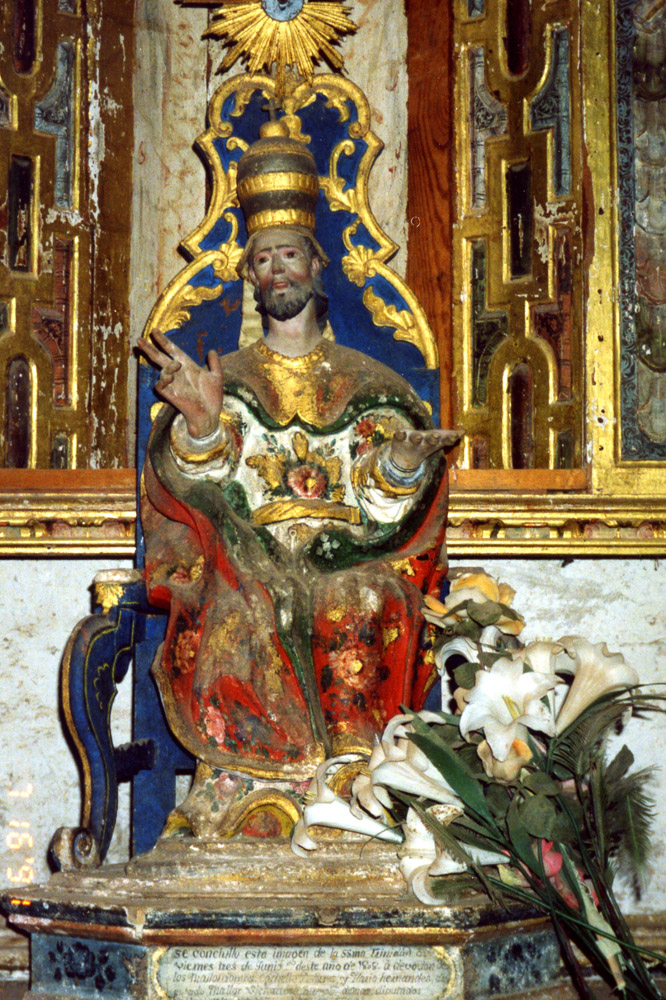Trinity:
Written on the hexagonal stand on which
the statue is set: Se conclullo [sic] este
imagen de la SSma Trinidad el viernes tres de junio
deste año 1808 a devocion de los Mallordomos.....
y Luis Hernandez.... Mallor.... diputados." (This
image of the Most Holy Trinity was completed on this
Friday, the 3rd of June as a an act of devotion on the
part of the Mayordomos... and Luis Hernandez... Mallor...
deputies.)
God the Father is a young man who looks in sadness
toward the right. He holds up his right hand, thumb,
index and middle finger extended in blessing. The left
hand is held palm upward and unnaturally flat. On it
must have sat the dove that would represent the Holy
Spirit. The use of the Host as a symbol of Christ is a
significant departure from the crucifix set on a mappa mundi
orb that is usually
presented to the world by the Father in Trinity statues.
The fact that it is higher than the Father and is in an
monstrance
suggests a parallel with the priest's offering of the
host at Mass.
The gold and red cope is the kind that is always worn
by the Father and almost never by anyone else. In this
case, there is no "pin" to close it. The artist was more
interested in the broad curve of gold that forms the top
of the cape and dramatizes the head. Unique to all the
Trinity statues we have seen, the swirl of the gold and
red cape forms a heart shape out of which the hand
extends. The statue wears a robe of white
decorated with a large red rose framed in three gold
petals just above the gold belt. Smaller roses can be
seen on the sleeves and at the hem.
The throne is deep blue trimmed in gold. It has been
planned not so much as a seat but as a retablo for the
statue. The high back rises in inverted curves to frame
the father's head and his tall crown and as repetition
of the curves of the mantle. At the very top are
positioned the sunbursts of the monstrance.
The chair's fiddle legs are not meant to support the
statue's weight. They open on either side of the
statue's legs, framing the bottom of the figure and
giving a solid base to the composition. The feet of the
statue appear at the hem of the robe, the left one
slightly higher than the right and resting on a stone
that is part of the base. The whole is then set on the
blue and gold base on which is written the message
transcribed above.
Local Name: La Santísima
Trinidad.
Basis for Identification: Father
enthroned, wearing triple cope and triple tiara. Son
represented by monstrance
above.
Other characteristics: The dove is
missing.
Site: Church of Santo
Domingo Yanhuitlán.
Location: Narthex
(see note).
Media and construction: Wood,
gesso, paint. Eyes: glass.
Comparable santos in Oaxaca: Diaz
Ordaz, Mitla,
Tamazulapan,
Teitipac,
Teotitlán,
Tlacolula,
Xoxocotlán,
Tlacolula 2
External Links:
Wikimedia Commons:
Throne
of Mercy in Mexico.
Catholic
Encyclopedia: The
Blessed Trinity
Wikipedia: Trinity
Christian Iconography: The
Trinity
Next: Also in the narthex, an altar with
another Trinity and an unidentified saint
Introduction
to the church at Yanhuitlán
Santos Home Page
Note: On
this
site,
references to the cardinal directions always assume
that the main altar is at the east end of the church,
the narthex or entry area at the west end, and the two
walls
of the nave on the
north and south. (The
nave is the long central section.)
Actual orientations may differ.
The photo shown here is licensed under the
Creative Commons Attribution-Share Alike 3.0 Unported
license. You are free to share or remix it on two
conditions: first, that you attribute it to the
photographers, Claire and Richard Stracke, without
implying any approval of your work on their part;
second, that if you alter, transform, or build upon this
photo, you may distribute the resulting work only under
the same or similar license to this one.
|


